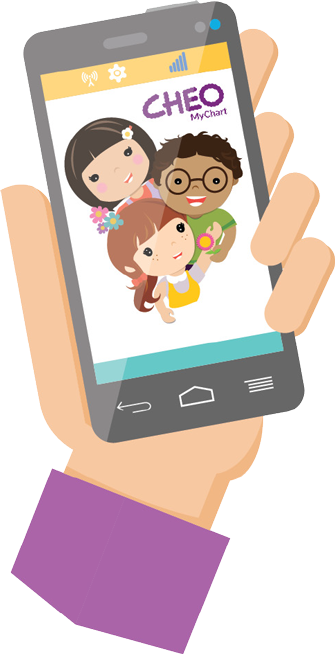
For best results make sure background graphics are enabled.
What is a peripheral nerve block?
A nerve block is a way to treat and prevent pain after surgery. Your child’s anesthesiologist injects medication near the nerves supplying the area where your child will have surgery. This numbing medication (or local anesthetic) - ropivacaine (long acting)- ‘freezes’ the area.
Anesthesiologists use nerve blocks to:
- Reduce pain after the surgery
- Decrease the need for pain medications and their side effects (nausea, vomiting, itching, sleepiness and/or constipation)
- Allow better rest following surgery
- Make it easier to take part in physiotherapy
There are two types of nerve blocks done at CHEO
After your child is sleeping/sedated, the anesthesiologist uses an ultrasound machine to see the nerve and inserts a needle to inject near it.
1) Single shot nerve block is a one-time injection. It helps control your child's pain for 6 to 18 hours.
2) Continuous nerve block. This kind of nerve block allows your child to receive numbing medication continuously after the initial injection. We can give the medication through a small tube (catheter) connected to a disposable pump lasting up to 48hrs.
Before your child goes home, the team will connect the catheter to a small pump filled with the freezing medication. We will provide the proper instructions for taking care of the pump and pain management. You do not need to return to hospital to remove the pump.
Continuous nerve blocks last as long as the numbing medication infuses through the pump and will keep working for 6 to 18 hours after the continuous infusion is stopped.
The anesthesiologist and surgeon will discuss with you and your child which type of nerve block your child will receive before going into the operative room. It may be possible that more than one nerve needs to be blocked for pain relief.
Today your child received:
☐ Single shot nerve block at am/pm
☐ Continuous nerve block was started at am/pm
What happens when it wears off?
Your child should be able to move their limb normally after 6 to 18 hours after receiving a single shot or after the continuous nerve block infusion stops. The feeling in the limb will also come back.
Follow-up post-surgery for patient receiving a continuous nerve block:
Your child will be visited by the pain team if they are admitted to hospital. If they are discharged home, you will receive a daily phone call for follow-up.
Pain medications at home
To prevent pain, give your child pain medication before the nerve block begins to fully wear off as per instructions from your surgeon that can be found on your child’s After Visit Summary received before discharge from the hospital.
Even if the nerve block is working, you may need to add pain medication. You may need to give your child pain medication if the pain score is more than 4 (on a scale of 0-10, where 0 means no pain and 10 means the worst pain possible).It’s easier to control pain when you give the pain medication earlier and as soon as your child can drink.
For single-shot nerve blocks, we recommend taking a dose of pain medication at bedtime to manage the pain as the nerve block may wear off during the night.
Watch for constipation. It may be a good idea to give your child Restorolax or Lax-a-day while they are taking opioid pain medication. You won’t need a prescription - ask your pharmacist for any questions about it.
Are there any side effects or risk from getting nerve block?
It is normal to feel numbness and heaviness in the affected area, this will go away once the nerve block wears off.
The risks associated to receiving a nerve block are rare and include:
-
The nerve block not working
-
Damage to the nerves which can cause numbness and tingling
-
Bleeding/hematoma
-
Infection
-
Toxicity from local anesthetic
Your anesthesiologist will check the kind of nerve block your child received and will give you any special instructions for that specific block.
☐ Interscalene nerve block (neck injection) may cause feeling that you can't take a full breath, arm weakness, hoarseness of the voice, droopy eyelid and/or pinpoint pupil on the blocked side.
☐ Femoral block (groin injection) may cause leg weakness.
☐ Popliteal fossa (sciatic) block (injection in the back of the knee of thigh) may cause foot weakness.
☐ Pectoral blocks may rarely cause pneumothorax (collapsed lung).
If your child has the following, call 613-737-7600, press 0 and ask for the Anesthesiology resident on call to be paged.
-
Increased anxiety, shortness of breath, difficulty breathing, shakes and/or tremors
-
Signs of infection, like redness, swelling, pain and/or discharge at the catheter insertion site
-
Abnormal, intense pain at the surgical site or anywhere else on the blocked limb – this is most often a sign that the nerve block is not working and in very rare cases, it could be a sign of nerve damage
-
The limb is still numb longer than 24 hours after a single shot block or after the removal of continuous catheter.
Who to call?
Call 613-737-7600, press 0 and ask for the anesthesiologist resident to be paged for the first 72 hours for any pain related to the surgery.
For any other questions/concerns or any pain related concerns after 72 hours, please contact the surgeon’s clinic or go to your nearest emergency department.
Taking care of your child at home
Because your child can’t feel the frozen limb, you’ll need to take special care to protect the area from injury:
-
Always support and protect the frozen limb. Raising the limb on a pillow may help to reduce pain.
-
Keep the limb in a comfortable position.
-
Make sure that there is nothing pressing on the frozen limb .
-
Make sure the limb doesn’t get too hot or too cold. Your child won’t have the same sense of feeling in the area, so may not feel heat, cold or other things the same way.
-
Avoid excessive activity involving the frozen limb. Your child can't feel or control the limb while it’s frozen.
-
Take care to avoid injury to the areas. Make sure your child wears a sling and/or use crutches if ordered by the surgeon.
-
Your child shouldn't try to bear weight on a numb leg or use a numb arm for support.
Caring for the injection site
Check the nerve block injection site for the next two days for leaking, redness or discharge.
Continuous nerve block pump care at home
If your child’s pain is not under control, check tubing for closed clamps or kinks. Also check to make sure there is medication in the pump.
Keep the dressing over the catheter clean and dry. It is normal to have a small amount of clear or pink-colored drainage under the dressing. Leakage is not a concern if pain control is good. Do not change the dressing as the catheter is not stitched in place and could come out if you remove the dressing. If you need to, reinforce the dressing with a large Tegaderm.
Your child will not be able to have a shower or tub bath while the catheter is in place. A sponge bath is okay.
Follow your surgeon’s activity restrictions.
Please see the instruction manual on how to check infusion status. Don’t drop the pump and keep it out of the water. If your child is using ice for comfort, keep it away from the lower part of the pump tubing.
The pump infuses the nerve block medication and will not allow you to make any adjustments to it.
It gives the numbing medication very slowly – it may take more than 24hrs before you notice a change in the size or look of the pump. It will gradually increase as the infusion continues. it will “collapse” as it empties
If your anesthesiologist decides that your child will need the medication infusion for longer than 48hrs, you may have to return to CHEO for a pump replacement.
Removing the catheter
You will remove the dressing and catheter at home. The anesthesiologist will tell you when to do this. Any remaining numbness your child has been feeling goes away within 24hrs after the catheter is removed.
To remove the catheter:
-
Gently lift the adhesive dressing covering the catheter insertion site. You may also remove any remaining tape.
-
Grasp the catheter as close you can to where it enters the skin and gently pull it out. This shouldn’t cause any discomfort. You shouldn’t notice any resistance when you pull. A small amount of blood of fluid draining is normal.
If you feel resistance as you pull the catheter, or if the catheter stretches, STOP. You could break the catheter if you keep pulling. Wait 30-60 minutes and try again. If you have trouble removing the catheter when you try again, call the anesthesiology resident on call.
Once removed:
-
Hold pressure over the site for one minute with a sterile gauze pad. Then apply a band-aid. You may remove the band-aid later that day.
-
After removal, check the tip of the catheter for a black dot. This tells you that the entire catheter was removed
-
Wash the skin with alcohol swab to remove any surgical soap or adhesive near the site
-
Throw the catheter, tubing and pump in the garbage. Do not try to remove any leftover medications. The medication does not contain any narcotic drug. It can’t be taken by mouth or intravenous (IV) injection. People can have toxic reactions if the medication is injected into a vein.
-
If you experience any persistent weakness, numbness, tingling, or other abnormal sensation for over a week after surgery, please contact your surgeon, who can alert the anesthesia team if needed.
Questions?
Related to nerve block and/or general anesthesia before the day of the procedure:
Pre-anesthesia clinic: 613-737-7600 ext. 2522 or via MyChart - Pre-anesthesia nurse
Related to the surgery/procedure:
Orthopedic Clinic (C4): 613-737-7600 ext. 2407
Plastic Surgery Clinic (C6): 613-737-7600 ext. 2325
Have you registered for MyChart?
MyChart is a FREE secure, online patient portal that connects patients to parts of their CHEO electronic health record, anywhere, at any time.
To apply for MyChart access, visit cheo.on.ca/mychart and fill out the MyChart access request form. Once your application has been approved, we'll send you an email with an activation code and instructions on how to log in and get started.





